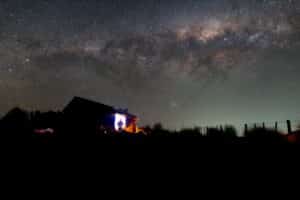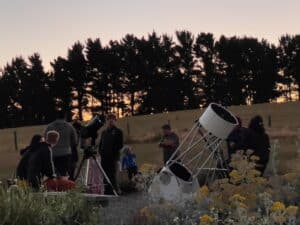Pavo is a circumpolar constellation if viewed from mid-latitudes in the southern hemisphere. The brightest star in the constellation of Pavo is the Peacock – Alpha Pavonis, though it is commonly referred to as the eye of the peacock (Whyte, 1928, p. 264).
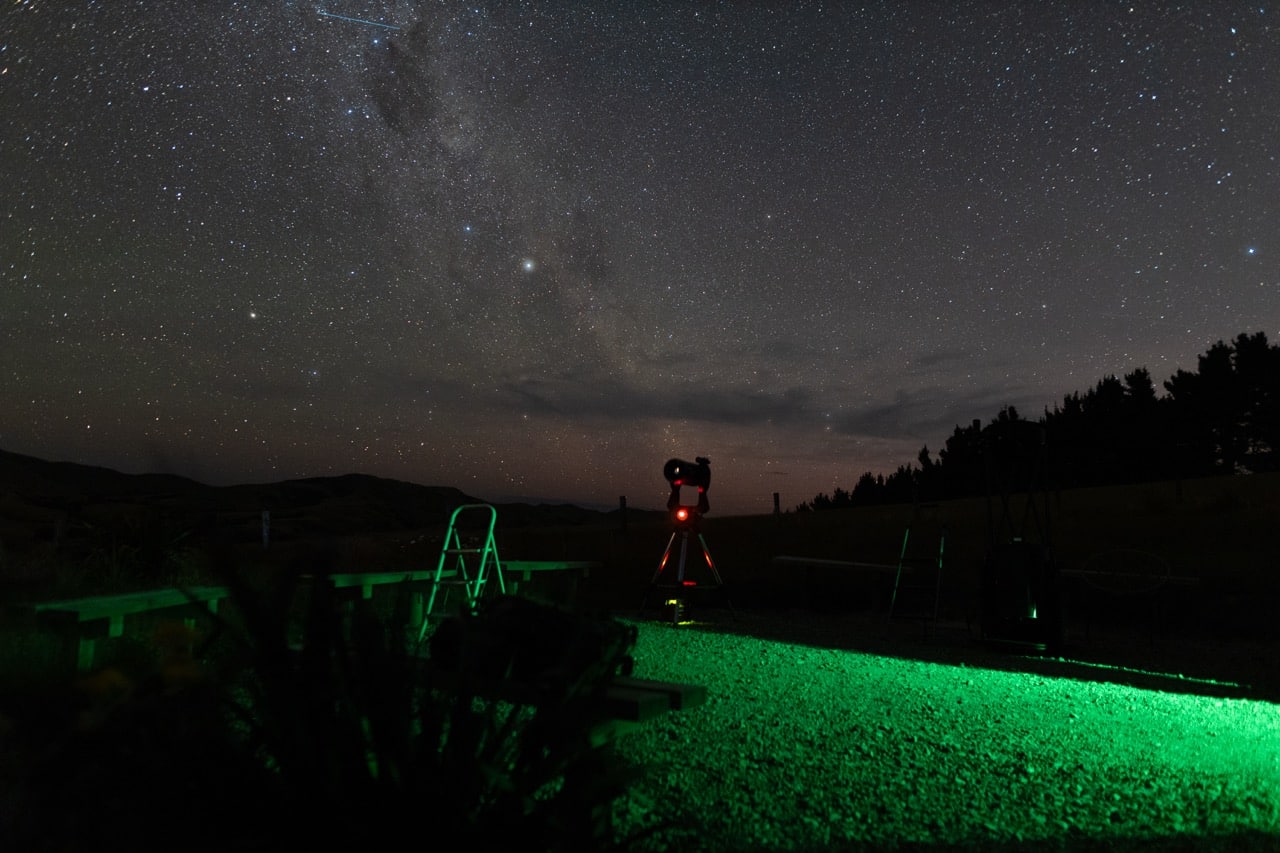

The rest of the constellation comprises less prominent stars. It’s in the group of constellations surrounding the South Celestial Pole – with Apus, Octans and Chamaeleon in the middle, and Pavo is in the next ring of constellations out. It sits between Octans and Sagittarius and is circumpolar if viewed from Star Safari Observatory.
The Stars of Pavo
The area bounded by Pavo contains few particularly bright stars, other than Peacock. During the Full Moon, the stars associated with the various Pavo asterisms are visible, but the observer must use techniques such as averted vision.

The most prominent star in Pavo is the bright sunlike star, Peacock. Also known as Alpha Pavonis, it was named Peacock by the Royal Air Force (RAF) Navigation Almanac. The RAF insisted on naming stars; since Alpha Pavonis lacked a name, it was given one (Sadler, 2008, p. 48). Peacock is a hot blue star with the spectral class B2 IV and a visual magnitude of 1.918 (Hogg et al, 2000). It has a surface temperature of around 19,000K and is 180 light-years away (van Leeuwen, 2007). That temperature means the star looks a little blue, hence its spectral class of B2. The IV indicates it is in the subgiant phase of its life cycle. This occurs when the star starts to run out of hydrogen in its core for fusion, and it begins to expand. The star is also binary with a smaller companion star (Vidal-Madjar et al, 1988, p. 274).
Pavo is more than just the eye of the peacock; the other stars have some interesting characteristics, including binaries and red giants.
Asterisms of Pavo
Observers of the night sky generally recognise various patches in the sky by the asterisms they are familiar with. The asterisms associated with Pavo include a rough outline of a peacock and other combinations of lines between stars. There is also a lesser-known asterism that resembles a saucepan. As this part of the sky doesn’t have many bright stars, there aren’t many published references to this area beyond European sources. The examination of oral traditions in the southern hemisphere is an area that needs much more work.
Deep Sky Objects Visible in Pavo
There are two prominent deep sky objects in Pavo, NGC 6744 and NGC 6752 (McIntyre et al, 2024, p. 161). NGC 6744 is a prominent spiral galaxy, and NGC 6752 is a globular cluster. The galaxy is relatively easy to find, about a quarter of the way along a line between Lambda and Delta Pavonis. Similarly, NGC 6752 is about a quarter of the way along a line from Lambda Pavonis to Peacock.
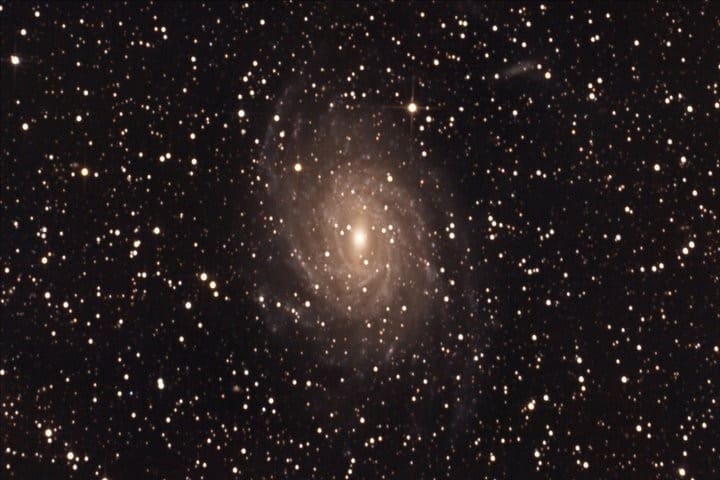
In our 405mm reflecting telescopes, NGC 6744 is evident, with a bright core and a diffuse haze around it; the spiral arms are not easy to see, but in ideal conditions an observer can see some variation in the haze around the core. The distance to the galaxy is about 30 million light-years (Tully et al, 2023). The globular cluster NGC 6752 is easier to see and visible even during a Full Moon. The distance to NGC 6752 is about 14,500 light-years (Gratton et al, 2003, p. 538).
A triangle between Delta, Gamma and Epsilon Pavonis bounds a group of 11th magnitude galaxies. With a powerful telescope, these galaxies are great to try and find, though you will need a dark sky and no Moon. The two brightest in the group are NGC 6876 and NGC 6872. NGC 6872 is one of the largest spiral galaxies known (Horellou & Koribalski 2007, p. 155). Both galaxies are clearly visible in a 405mm telescope, as are the fainter nearby galaxies. Close to the 5.4 magnitude star, Sigma Pavonis, are two more galaxies, NGC 6943 and the thin IC 5052.
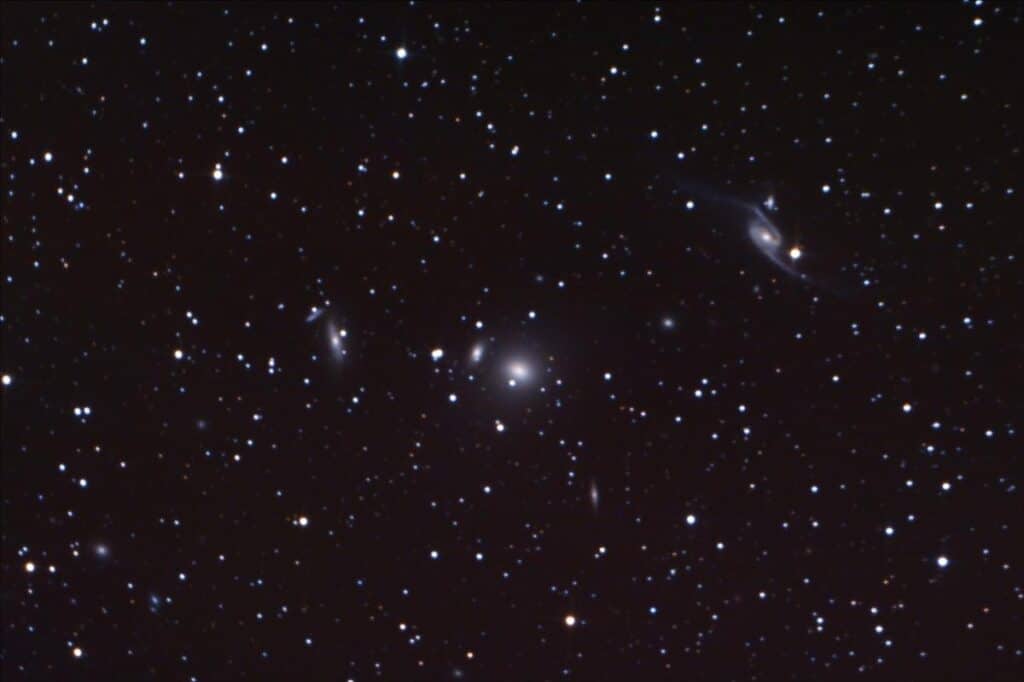
History of Pavo
The International Astronomical Union (IAU) defines a constellation as an area of the sky marked by boundaries with the 88 constellations first noted in 1922 (International Astronomical Union, 1922, p. 179). The boundaries are defined by points positioned on the Celestial Sphere at specific Right Ascension and Declination coordinates (Delporte, 1930). This is distinct from the patterns interpreted from the arrangement of stars. The IAU sector for Pavo is named after a group of stars noted by the Dutch navigator Pieter Dirkszoon Keyser (Sawyer Hogg, 1951, p. 215). Keyser’s observations were most likely the basis for the star map produced by Peter Plancius in 1594, titled “Orbis terrarum typus de integro multis in locis emendatus Petro Plancio, 1594” (Knobel, 1917, p. 414).
Pavo is Latin for Peacock, and the IAU decided in their 1922 meeting to keep the constellation names in Latin (International Astronomical Union, 1922, p. 179). The origins of the constellation’s name, The Peacock, are a little unclear. It all seemed to start with the desire of Dutch astronomer Petrus Plancius to map the southern sky, which was largely unknown to Europeans at the time. He relied on the observations made by Pieter Dirkszoon Keyser, who seems to have been under Plancius’ instruction before embarking on his voyages to the Indian Ocean (Knobel, 1917, p. 420).
The catalogue of stars returned to Plancius was then used by Jodocus Hondius to depict the southern sky on an engraved celestial globe. It seems that Plancius chose the peacock and other birds to make constellations from the stars that Keyser sent back (Dekker, 1987, p. 467). The new constellations essentially recorded the bird species the Dutch navigators encountered during their voyages to Southeast Asia.
The story doesn’t end there; the complicating factor is trying to unpick how the Pavo stars got catalogued and named, ultimately making it into Bayer’s Uranometria. The discussion must also include Frederick de Houtmann, who was on the same voyage as Keyser and also on a subsequent journey. During these voyages, he claimed to have collected data that he later published in his catalogue of stars, as an appendix to a dictionary of the Malaysian and Malagasy languages (Verbunt & Gent, 2011, p. 1).
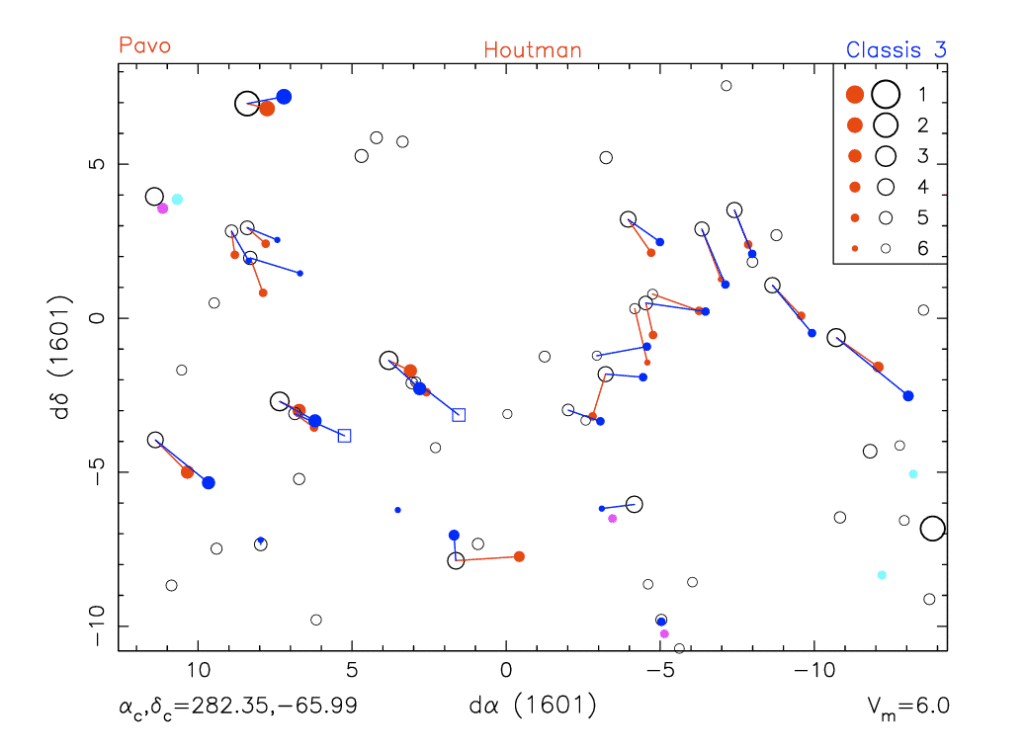
The star catalogue compiled by de Houtmann did not use the Greek letter followed by the constellation name as Bayer did on some of the stars he depicted. The main question is whether Bayer used de Houtmann’s data or Keyser’s; it was probably a combination of both. Plancius used Keyser’s data to depict the peacock on Hondius’ globe, and the peacock appeared in Bayer’s drawings. The data de Houtmann published served as the basis for where Bayer placed the stars. Did de Houtmann copy Keyser’s data to get the positions, or did he measure them himself? We don’t know, but de Houtmann knew mathematics and astronomy, so it was likely within his ability to make the measurements himself (de Grijs, p. 13).
Peacocks are popular throughout Europe and can be found on many wealthy estates. In the late 1500s, they would have been a rarity and exotic, so immortalising the bird in the sky may have been a tribute to the Dutch maritime trade power.
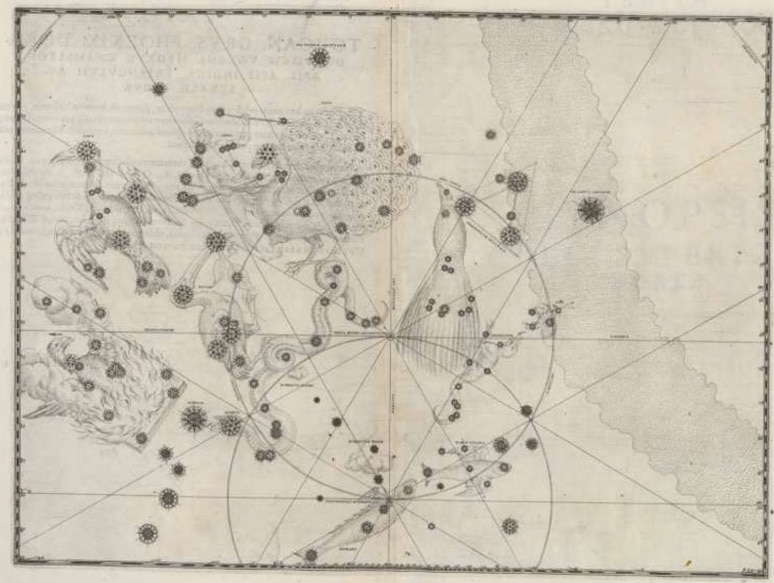
References
Bayer, J 1603, Uranometria, Zurich.
Chevalley, P 2019, Cartes du Ciel, <https://www.ap-i.net/skychart/>.
Dekker, E 1987, ‘Early explorations of the southern celestial sky’, Annals of Science, vol. 44, no. 5, pp. 439-70
Delporte, E 1930, Délimitation Scientifique Des Constellations (Tables et Cartes), Cambridge University Press, Cambridge.
Gratton, R, Bragaglia, A, Carretta, E, Clementini, G, Desidera, S, Grundahl, F & Lucatello, S 2003, ‘Distances and ages of NGC 6397, NGC 6752 and 47 Tuc*’, Astronomy & Astrophysics, vol. 408, pp. 529-43.
de Grijs, R 2023, ‘Early star charts of the Dutch East India Company’, Sydney.
Hog, E, Fabricius, C, Makarov, VV, Urban, S, Corbin, T, Wycoff, G, Bastian, U, Schwekendiek, P & Wicenec, A 2000, ‘The Tycho-2 Catalogue of the 2.5 million brightest stars*’, Astronomy & Astrophysics, vol. 355, pp. L27-L30.
Horellou, C & Koribalski, B 2007, ‘Stars and gas in the very large interacting galaxy NGC 6872’, Astronomy & Astrophysics, vol. 464, pp. 155-65.
International Astronomical Union, IA 1922, ‘Meeting of the International Astronomical Union at Rome 1922 May 2-10’, The Observatory, vol. 45, pp. 176-190.
Knobel, E 1917, ‘On Frederick de Houtman’s Catalogue of Southern Stars, and The Origin of the Southern Constellations’, Monthly Notices of the Royal Astronomical Society, vol. 77, no. 5, pp. 414-432.
van Leeuwen, F 2007, ‘Validation of the new Hipparcos reduction’, Astronomy & Astrophysics, vol. 474, pp. 653-64.
McIntyre, M, Ridpath, I & Federman, R 2024, Stargazer’s Bible, William Collins, Malaysia.
Merula, P, Hondius, H & Elsevier, I 1621, Paulli G.F.P.N. Merulae Cosmographiae generalis libri tres : item Geographiae particularis libri quatuor, quibus Europa in genere, speciatim Hispania, Gallia, Italia, describuntur, Amsterodami : Apud Henricum Hondium.
Sadler, D 2008, A Personal History of H.M. Nautical Almanac Office, United Kingdom Hydrographic Office.
Sawyer Hogg, H 1951, ‘Out of Old Books (Pieter Dircksz Keijser, Delineator of the Southern Constellations)’, Journal of the Royal Astronomical Society of Canada, vol. 45, pp. 215-20.
Tully, R, Kourkchi, E, Courtois, H, Anand, G, Blakeslee, J, Brout, D, de Jaeger, T, Dupuy, A, Guinet, D, Howlett, C, Jensen, J, Pomarède, D, Rizzi, L, Rubin, D, Said, K, Scolnic, D & Stahl, B 2023, ‘Cosmicflows-4’, The Astrophysical Journal, vol. 944, no. 94, p. 31.
Vidal-Madjar, A, Ferlet, R, Spite, M & Coupry, M 1988, ‘Deuterirum in early-type stars. The case of Alpha Pavonis’, Astronomy & Astrophysics, vol. 201, pp. 273-5.
Whyte, C 1928, The Constellations and their History, Charles Griffin & Company Ltd, London.
Verbunt, F & van Gent, R 2011, ‘Early star catalogues of the southern sky’, Astronomy & Astrophysics, vol. 530, pp. 1-26.

